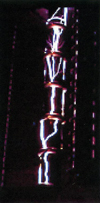
|
|
|
Dick's life with physics, page 3 |
|
|
|
|
|
Meanwhile Dick had joined Jack Dainty's group, working on the recently purchased Cockcroft-Walton high voltage accelerator. When Jack moved to Kings Buildings in 1951 to combine interests in nuclear physics and botany, Dick took over the running of the H T lab and supervision of the research students working there on the structure of light nuclei. Perhaps unwisely, he would not put his name on published papers unless he felt that he had done a substantial part of the work - advice, ideas and technical fault-finding did not count - and he insisted that authors be listed in alphabetical order, so his citations were meagre. Among his teaching commitments he got great satisfaction from working with Michael Smyth, a young lecturer in the Astronomy department, to devise an Astrophysics option for Honours students. This would include the course on quantum mechanics which Dick gave for many years and which astronomer Mary Brück has called "that almost legendary course". Of all Dick's dozen colleagues in the Natural Philosophy department at that time, by far the most congenial was E G Dymond. Gil had worked on electron scattering in Göttingen, Princeton and Cambridge in the heady days of the 1920s, before coming to Edinburgh as a Carnegie teaching fellow. He took part in the 1937 Wordie expedition to the Arctic, to measure high altitude cosmic radiation near the north geomagnetic pole. Incidental discovery of unexpectedly low wind speeds in the arctic air led to collaboration with the department's meteorologist, James Paton. A decade later one of Gil's radio-sondes, launched in South Queensferry at sunrise, sparked a rumour of flying saucers, much to the amusement of his colleagues. When Gil died suddenly on 26 October 1952, Dick was devastated. His sense of academic isolation was mitigated by his friendship with Emil Wolf who had come to Edinburgh the previous year to help Max Born translate and update his book, Optik. During his post-doctoral work on diffraction theory in the Cambridge University Observatory, Emil had travelled frequently to London to attend meetings of the Optical Group of the British Physical Society. There, he met Dennis Gabor whose ideas on optical coherence and wavefront reconstruction (holography) were to be incorporated in Born's book. Emil was only in Edinburgh for a little over 2 years, until shortly after Born retired, but Dick spent many happy evenings with him, discussing Gabor's ideas and Emil's discovery that a satisfactory theory of optics could be based on observable quantities - new insights that influenced some of the experiments Dick devised for the honours laboratory. Throughout his life, Dick felt that he owed the world a living. In return for his salary he felt his primary obligation was to the students; his own research was an enjoyable adjunct, necessary to keep his teaching alive. His lectures were always freshly thought out, spiced by appropriate demonstrations supported by Mr Thomson who looked after the department's historic collection of apparatus. The tradition of taking the Honours students to The Burn for a week of intensive study, walking, talking and 'gracious living' was started by Dick in September 1952. Most of the ex-servicemen had by now completed their studies, and these much younger students had little experience of life beyond school and university. Outstanding among this first group was Enid MacRobbie. She stayed at Edinburgh after graduating and became the first graduate student in Jack Dainty's new biophysics research group. Her subsequent career in Cambridge is legendary, as is that of Archie Howie who, with Tom Kibble, was in the cohort which graduated in 1956. Dick's lectures on quantum mechanics came after a rather mathematical course on wave mechanics by Jim Hughes, and Dick's informal style gave the students confidence to ask questions; these always got very careful consideration. Archie Howie remembers that about half of one lecture was devoted to dealing with a question raised the previous day. Others remember "a young enthusiastic lecturer with a lovely sense of humour and a real understanding of the difficulties we students had in understanding some aspects of physics". It was not surprising, then, that Dick decided to write a book on the subject. Non-Relativistic Quantum Mechanics - an introduction was largely written during the mornings of July, 1958, and was published in 1960. It was the first Edinburgh University Press textbook to make a profit. A subsequent tempting offer from another publisher, for a more elementary book, had to be turned down since Archie Turnbull of the EUP, backed up by Principal Sir Edward Appleton, argued that it would be using work done for the first book. The revised 2nd edition of NRQM came out seven years later, with a topical appendix on the density matrix. As a student of English, Archie had been one of a group with whom Dick had 'hung out' in his own student days, sitting on the grass which then enhanced the Old Quad; he joined the Lovat Scouts, and came back to Edinburgh after the war to proof-read Chambers Dictionary, and even add some beguiling entries. For Archie, "design to the book was as dung to the field". |



|
| Site index |